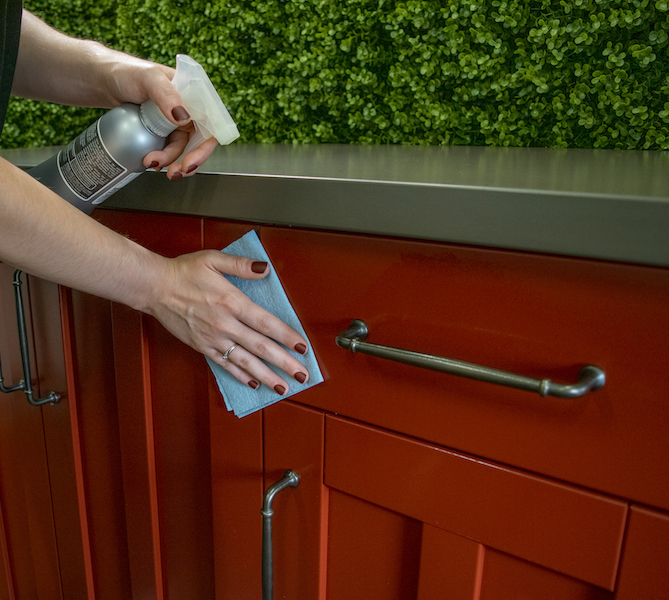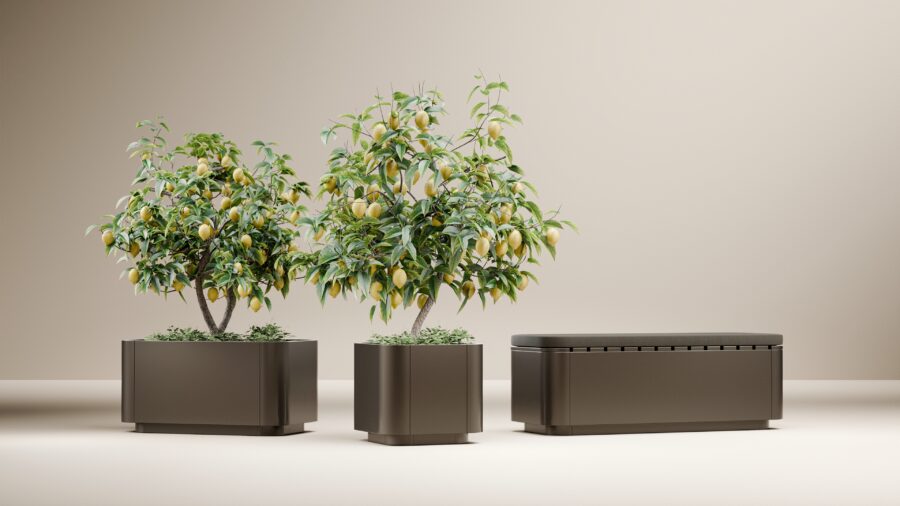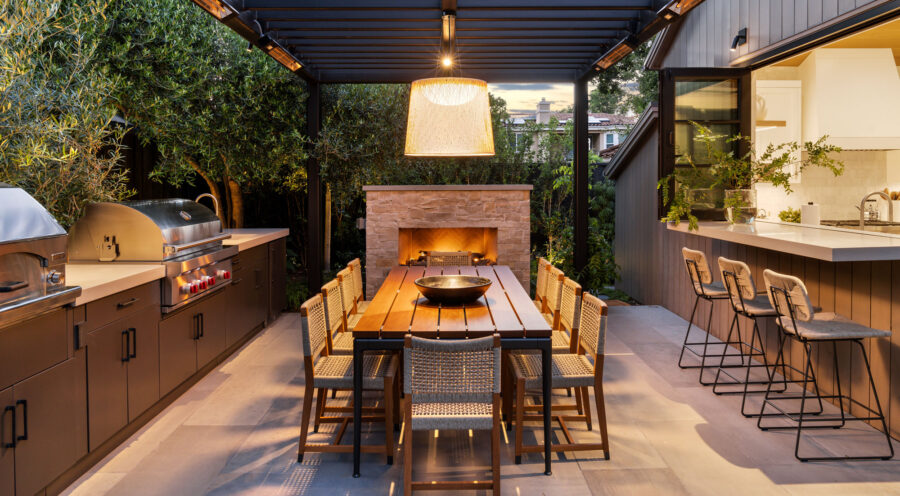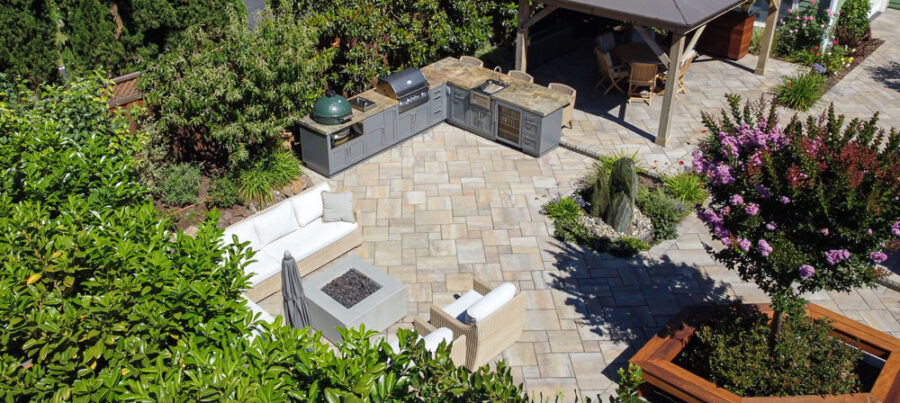As any homeowner can attest, maintaining the outside of your home – including your backyard – is just as important as the interior. However, knowing the proper way to care for entertainment equipment, appliances, and furnishings, including your deck and outdoor kitchen cabinetry, takes a certain degree of know-how.
Although it’s not necessarily difficult, most of us would like to know not only the easiest way to keep our outdoor entertaining area looking great, but how to cut down on labor – in other words, how to spend more time enjoying ourselves outdoors, and less time cleaning!
In this article, we’ll explore tips for cleaning kitchen cabinets, the different types of maintenance required for your exterior kitchen cabinets based on material, and other helpful hints to keep in mind. With the proper knowledge, care, and TLC, you’ll be on your way to developing a custom maintenance plan so you can enjoy your outdoor dining area for a lifetime. First off, let’s dive into how to keep your outdoor kitchen clean.
How to Keep an Outdoor Kitchen Clean
– Cabinet Care 101: Guidelines to Keep Your Outdoor Cabinetry Looking Pristine
– Best Way to Clean Kitchen Cabinets by Material
– Weatherproofing Cabinets: Winterize
An outdoor kitchen is meant to withstand the outdoor elements, but keeping it clean is important. You should clean the sink and wipe down the counters before cooking to avoid your ingredients and utensils being on a dirty surface. The outdoor kitchen is likely to gather debris and dust throughout the day and therefore, we recommend using a cloth and soapy water on the surfaces before you start cooking.
Cabinet Care 101: Guidelines to Keep Your Outdoor Cabinetry Looking Pristine
A focal point to any residence, your outdoor kitchen may quickly become one of your favorite spots to entertain, especially in the warmer months. Ideal for those who love to host parties, families who enjoy spending time together outside, or nature lovers in general, a custom entertainment area in your yard or rooftop is not only a great addition to your home, but can add resell value to your property.
Related – Does an Outdoor Kitchen Add Value to a Home?
Keeping all of these things in mind, educating yourself on proper cabinet care will allow you to extend your kitchen cabinets’ lifespan while keeping it looking its very best. Here are a few general rules of thumb to follow:
Wash
Whether they’re lightly soiled from regular use or coated by a film of salty water due to beach proximity, cleaning your outdoor cabinets on a regular basis is one of the easiest ways to ensure their longevity. Although protocols may vary slightly depending on material and manufacturer, it’s safe to say that using a soft, non-abrasive cloth or sponge soaked in water can be a simple and effective way to remove superficial residue.
Once you’ve determined if gentle detergents are okay to use, we always recommend you clean in the direction of the grain (for all materials). Go easy during the drying process, too: using a chamois cloth or other soft towel, be sure to wipe off any excess moisture to ensure no unsightly spots are left behind.
Protect
As mentioned, be sure to carefully read the accompanying literature that comes with your outdoor kitchen cabinets, as well as any info that may be available online. If you have questions about cleaning solutions or protectants, you can also ask the cabinet manufacturer. Whoever installed your cabinetry can also assist you with maintenance inquiries.
Once you’ve determined the appropriate cleansers and protective agents, incorporate them into your routine to keep backyard kitchen cabinets looking their best while extending their longevity. Additionally, you should never scrub or scrape your cabinetry with anything abrasive, as this can result in permanent damage.
Finally, be mindful of chemicals such as chlorine or other pool treatments. Because they emit potent fumes, they can actually corrode cabinet hinges. To limit such damage, you may wish to apply silicone spray such as WD-40 or another specially-formulated stainless steel protectant – as in every case, be sure to check with the experts before utilizing any kind of cleanser, protectant or maintenance treatment.
Helpful Tip: If you’re located on waterfront property or in close proximity to saltwater, it’s essential to clean and maintain your outdoor kitchen cabinets and adjacent appliances more often to protect them from elemental corrosion.
Best Way to Clean Kitchen Cabinets by Material
One of the easiest ways to protect the appearance of your outdoor kitchen cabinets is to practice regular maintenance – besides keeping your outdoor culinary station looking its best, routine cleaning will protect your valuable investment so it may serve you for years to come.
However, not all cabinets are created equally – although most outdoor kitchen furnishings can be cleaned with a damp cloth, some require a more detailed maintenance regiment depending on what they’re made of. If you’re looking for a low-maintenance outdoor kitchen station, you’ll want to weigh your options carefully.
It’s important to take certain factors into consideration when choosing your cabinetry, including the region where you live (and the consequent climate conditions), your budget, and of course, ease of care.
Related – Choosing Cabinets for Your Outdoor Kitchen: A Comprehensive Guide
Below, an overview of outdoor kitchen cabinets constructed of different materials so you can see the pros and cons of each:
Stainless Steel Cabinets
For outdoor cabinetry made of stainless steel, it’s essential to realize one major detail – they’re designed to withstand normal wear and tear, but they aren’t completely impervious to stains. Therefore, you’ll want to routinely clean all of your outdoor kitchen components, including cabinets, door & drawer hardware, BBQ grill, cabinet pulls, appliances, and other entertainment elements made of stainless steel.
One of the most fool-proof forms of stainless steel maintenance comes in the forms of sealers and finishers – check with your cabinet’s manufacturer or vendor first to ascertain the appropriate treatments. Once you’ve confirmed appropriate cleaning methods, safe detergents, and suitable sealant agents, be sure to clean stainless steel cabinets and appliances thoroughly with a damp cloth, removing any debris, dirt, excess grease, dust, pollen, etc. before treating them with any type of sealant.
You’ll also want to keep in mind these two vital tips: first, never use anything abrasive on stainless steel – scrubbing aggressively or using items such as steel wool can mar, scratch, and scuff up the surface. Always follow maintenance instructions to ensure the life of your cabinetry. Secondly, don’t wait till it’s too late – in other words, maintain a regular cleaning routine. A periodic preventative cleaning & protection regiment will prevent superficial and fundamental problems from cropping up.
CONTACT US ABOUT OUR OUTDOOR CABINETS
Wood Cabinets
If you prefer the natural look of genuine wood, a regular cleaning and maintenance routine for is essential. Because most types of wood are prone to damage when exposed to the elements, there are a limited range of varieties appropriate for outdoor applications – the three major types of wood used in outdoor kitchen cabinetry includes teak, bamboo, and cypress.
As in any case, be sure to ask your vendor or check the manufacturer’s specs before applying any cleaning agent or other chemicals to your cabinets. Since water and high levels of humidity are natural enemies to your outdoor cabinets, they should be oiled on a regular basis to moisturize, safeguard, and waterproof the wood against the harsh elements.
In addition, routine oiling will maintain the wood’s natural luster while protecting them from other climate factors, such as the damaging UV rays associated with direct sunlight exposure. Exercise caution if you are thinking about painting or staining your cabinets – it’s best to consult with a professional, as you could potentially damage the finish (particularly if you are not familiar with the refinishing/staining process). In the case of paint, it’s not recommended, particularly if your cabinetry is made of expensive hardwoods like teak – you’ll ruin the finish and diminish their value and beauty.
Polymer Cabinets
A popular and cost-effective option, polymer kitchen cabinets are a low-maintenance choice. However, be sure to research your options carefully, though, as the standards of polymer cabinets can vary greatly. When you’re on the market for outdoor kitchen cabinets designed to last, look for marine grade polymer for maximum durability.
Like stainless steel, one of the best features is ease of maintenance. Although they’re a contender for an easy-to-care-for outdoor option polymer cabinets are susceptible to warping and losing their shape over time.
Did You Know…
- Cabinet maintenance doesn’t just end at the doors and countertops – be sure to clean your stainless steel hardware on a regular basis with a stainless steel cleaner. Follow up with a steel protectant to extend your efforts.
- Certain household items are suitable for your clean routine – a little bit of WD-40 on a Scotch-Brite™ pad (if used very gently) can remove surface rust and corrosion on a variety of hardware surfaces, while removing marks and signs of wear & tear. As we’ve mentioned, be sure to consult with your vendor or the maintenance guide before taking any type of cleaning agent, chemical, stain, protecting agent or textured scouring pad to the surface of your outdoor kitchen cabinetry.
Weatherproofing Cabinets: Winterize
When the temperatures start to dip down, it’s time to cover up – be sure to prepare your outdoor kitchen area for the colder months. Once summer slips into autumn, you’ll want to get your patio or backyard furnishings ready for the change of seasons, and that includes your outdoor cabinetry and appliances.
Cold weather can wreak havoc on your outdoor kitchen, resulting in unnecessary and costly repairs. Therefore, it’s wise to take special precautions and winterize your outdoor cabinetry according to the material, as well as the manufacturer’s instructions. Be sure to cover the surfaces of your outdoor oasis (including cabinetry and appliances) to avoid cracks, stains and weathering from freezing temperatures and damp conditions.
It’s important to proceed with caution when covering any surface – check for preexisting patches of moisture to ensure you don’t trap any underneath a tarp or canvas cover, as this can actually lead to more damage than if your furnishings were directly exposed to the elements. When in doubt, contact the cabinet manufacturer or vendor to determine the best methods of protection and winterizing.
When the temperatures start to dip down, it’s time to cover up – be sure to prepare your outdoor kitchen area for the colder months. Once summer slips into autumn, you’ll want to get your backyard furnishings ready for the change of seasons, and that includes your outdoor cabinetry and appliances.
Cold weather can wreak havoc on your outdoor kitchen, resulting in unnecessary and costly repairs. Therefore, it’s wise to take special precautions and winterize your outdoor cabinetry according to the material, as well as the manufacturer’s instructions. Be sure to cover the surfaces of your outdoor oasis (including cabinetry and appliances) to avoid cracks, stains, and weathering from freezing temperatures and damp conditions.
It’s important to proceed with caution when covering any surface – check for preexisting patches of moisture to ensure you don’t trap any underneath a tarp or canvas cover, as this can actually lead to more damage than if your furnishings were directly exposed to the elements. When in doubt, contact the cabinet manufacturer or vendor to determine the best methods of protection and winterizing.
Note, although powder coated stainless steel can be left uncovered in the winter months, covering adds extra protection which can never hurt.
Related – Benefits of Powder Coating Outdoor Kitchens
Other Helpful Weatherproofing Tips
Before the cold completely settles in, be sure to thoroughly clean your barbecue grill – scrape debris from the grates, and wipe away any spills or stains. This will ensure a smooth transition into the warmer months – i.e., less elbow-work cleaning and more time to enjoy cooking food outdoors!
Most importantly, you’ll want to invest in an appropriate cover to protect your grill against snow, ice and sleet – although some makes and models can withstand the harsh elements, researching a proper cover can ensure the longevity of your grill. It’s important to select the right type of cover to make certain that moisture can escape and not pool on the surface, which can lead to damage and deterioration.
In addition, follow your manufacturer’s instructions carefully when it comes to winterizing your outdoor refrigerators, ice makers, and sinks. Finally, prepare your fire pit for the oncoming winter months – by observing these precautions and maintenance tips, you can rest easy knowing your outdoor kitchen and entertainment area is ready to go once spring arrives.
Call 203-269-2300 to learn more about our outdoor kitchen cabinets.
This article is based on industry knowledge and research by outdoor kitchen design professionals, including our in-house experts and engineers with decades of experience.Our goal at Danver is to provide factual information on relevant topics to help readers make informed decisions about their outdoor living spaces.
This article uses trusted sources with references hyperlinked to the source material.






